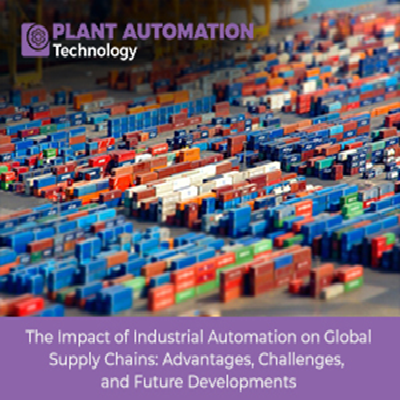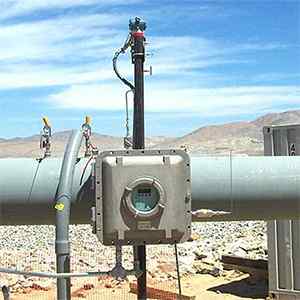The Impact of Industrial Automation on Global Supply Chains: Advantages, Challenges, and Future Developments

Introduction
Global supply chains have been forever altered by industrial automation. This has driven industries to unprecedented levels of efficiency, flexibility, and resilience. With the integration of advanced technologies like robotics, artificial intelligence (AI), and the Internet of Things (IoT), the era of supply chain management has emerged. In this in-depth discussion, we explore the multifaceted impact of industrial automation on global supply chains, exploring its numerous benefits, the challenges it presents, and the exciting potential for future developments.
Unleashing efficiency through automation
At its core, industrial automation seeks to optimize processes and minimize inefficiencies across the supply chain. Automated systems offer unparalleled precision and consistency, significantly reducing errors and delays at various stages of production, distribution, and logistics. Real-time data analysis enables businesses to proactively identify bottlenecks, anticipate demand fluctuations, and streamline inventory management, leading to cost reductions and improved resource utilization.
| Also Read: Supply Chain Resilience: Leveraging Automation for Business Continuity |
Automation empowers supply chain stakeholders with increased visibility, allowing them to track product movements and monitor critical performance indicators in real-time. Enhanced transparency promotes better collaboration and communication, fostering stronger relationships among suppliers, manufacturers, and customers.
Supply Chain Transformation and Digitization
The adoption of industrial automation is an integral part of the broader digitalization wave sweeping through supply chains worldwide. Embracing automation technologies facilitates the creation of interconnected systems and smart factories, where machines communicate seamlessly with each other and human operators. Digital transformation promotes data-driven decision-making, enabling companies to pivot quickly in response to market demands and unforeseen disruptions.
Automated data collection and analysis improve supply chain forecasting accuracy, empowering businesses to align production with demand more efficiently. Such precision optimizes inventory levels, reducing excessive stockpiling and storage costs.
Advantages and Challenges of Industrial Automation in Global Supply Chains
Advantages:
- Enhanced Product Quality: Automation ensures consistent product quality by minimizing human errors and variations in production processes.
- Increased Productivity: Automated workflows streamline operations, optimizing resource utilization and increasing overall productivity.
- Efficient Demand Management: Real-time data analytics enable efficient demand management, reducing excess inventory and stockouts.
Challenges:
- Initial Investment and Integration: Adopting automation requires significant investments in technology and personnel training, which can pose financial challenges for some businesses.
- Cybersecurity Risks: Interconnected systems are susceptible to cyber threats, necessitating robust cybersecurity measures.
- Workforce Transition: Automation may lead to job displacement, necessitating a focus on workforce reskilling and upskilling.
|
Also Read: Optimizing Inventory Management with Power Scraping Technology |
Sustainability in automated supply chains
Industrial automation is not solely about enhancing operational efficiency; it is also a critical ally in promoting sustainable practices. By optimizing processes and energy consumption, automation reduces supply chain environmental impact. Automation-enabled predictive maintenance extends machinery lifespan, reducing waste generation and increasing equipment sustainability.
Automated routing and logistics planning can lead to greener transportation solutions, minimizing fuel consumption and greenhouse gas emissions. As eco-consciousness gains traction among consumers and investors, sustainability-driven automation becomes a strategic advantage for businesses aiming to meet ethical and environmental standards.
Ensuring ethical automation practices
While automation benefits are evident, technology integration must be guided by ethical considerations. Workforce concerns take center stage in the age of automation, where job displacement and shifts in employment patterns become realities. Companies must prioritize upskilling and retraining initiatives, ensuring that the workforce is equipped to complement and collaborate with automation rather than being replaced by it.
Ethical automation practices also safeguard data privacy and cybersecurity. As supply chains become more interconnected and data-driven, measures to protect sensitive information and guard against cyber threats become paramount.
The Future of Automated Global Supply Chains
As industrial automation advances, the future of global supply chains appears promising, with a host of transformative technologies reshaping the landscape. The convergence of advanced robotics, autonomous last-mile delivery, 3D printing, and AI-driven decision-making can revolutionize supply chain operations, bringing about unprecedented levels of efficiency, flexibility, and responsiveness.
Advanced Robotics: Pioneering Versatile Automation
The next generation of robotics will redefine automation capabilities. More sophisticated and versatile robots equipped with advanced sensors and AI algorithms will possess human-like dexterity, enabling them to handle complex tasks with precision and adaptability. These advanced robots will excel in various industries, from manufacturing to logistics, performing intricate assembly processes and handling delicate items easily.
By incorporating advanced robotics, global supply chains can optimize production processes, enhance quality control, and reduce labor-intensive tasks. This innovation will increase productivity and free up human workers to focus on more strategic and creative aspects of their roles.
Autonomous Last-Mile Delivery: Transforming Logistics' Final Leg
Autonomous last-mile delivery solutions, powered by drones and autonomous vehicles, promise to revolutionize product delivery. These cutting-edge delivery methods offer efficiency and speed, enabling swift and precise deliveries to customers' doorsteps.
Drones, capable of navigating complex urban environments, can expedite small package and medical supplies delivery to remote or congested areas. On the other hand, autonomous vehicles can handle larger shipments, optimizing route planning and reducing carbon footprint.
Autonomous last-mile delivery integration into global supply chains will lead to enhanced customer satisfaction, reduced delivery times, and lower delivery costs.
3D Printing: Enabling On-Demand Manufacturing
3D printing, also known as additive manufacturing, is poised to revolutionize production processes within global supply chains. By creating products layer by layer using digital models, 3D printing eliminates the need for extensive inventory storage and transportation, making it a cost-effective and sustainable solution.
This technology offers unprecedented customization opportunities, enabling businesses to produce customized, tailor-made products in real-time, meeting individual customer demands easily. Additionally, 3D printing can reduce material waste and energy consumption, promoting sustainable manufacturing practices.
By embracing 3D printing, global supply chains can optimize inventory management, reduce lead times, and create more agile and adaptive production workflows.
AI-Driven Decision-Making: Empowering Data-Driven Supply Chains
The future of global supply chains will rely heavily on artificial intelligence (AI) and machine learning. As AI-powered analytics process vast amounts of supply chain data, they will offer real-time insights and predictive capabilities. This data-driven decision-making approach will revolutionize demand forecasting, inventory management, and distribution, fostering agile and responsive supply chains that adapt to market fluctuations.
By embracing AI-driven decision-making, global supply chains can minimize risks, optimize resource allocation, and enhance operational efficiency. Predictive analytics will empower businesses to anticipate disruptions and proactively adjust strategies, ensuring continuous adaptability in a dynamic market landscape.
Conclusion
Automated global supply chains are an exciting frontier where advanced technologies converge to create more efficient, flexible, and sustainable operations. Advanced robotics, autonomous last-mile delivery, 3D printing, and AI-driven decision-making are poised to drive significant transformation, reshaping product manufacturing, distribution, and delivery.
To stay ahead in this ever-evolving landscape, businesses must embrace these innovations, invest in research and development, and adopt a proactive mindset toward implementing the latest automation solutions. By leveraging the potential of these emerging technologies, global supply chains can thrive in an era of unprecedented efficiency and responsiveness.






